COTD: IS A LITTLE BIT OF HISTORIC PRESERVATION WORSE THAN NONE AT ALL? 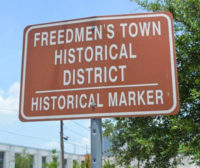 “A little late for that. There are so many new homes and townhomes and vacant lots in the area that there is almost no historic character left. It’s a prime area for redevelopment anyway — might as well let the developers finish the job and do it right so it’s not just a hodgepodge.” [Christian, commenting on City Wants To Create Historic District To Protect What’s Left of Freedmen’s Town Historic District] Photo of Freedmen’s Town Historic District sign: Freedmen’s Town Preservation Coalition
“A little late for that. There are so many new homes and townhomes and vacant lots in the area that there is almost no historic character left. It’s a prime area for redevelopment anyway — might as well let the developers finish the job and do it right so it’s not just a hodgepodge.” [Christian, commenting on City Wants To Create Historic District To Protect What’s Left of Freedmen’s Town Historic District] Photo of Freedmen’s Town Historic District sign: Freedmen’s Town Preservation Coalition
Quicklink
JUSTIN YU TO CLOSE OXHEART, SPEND SOME TIME IN THE HEIGHTS 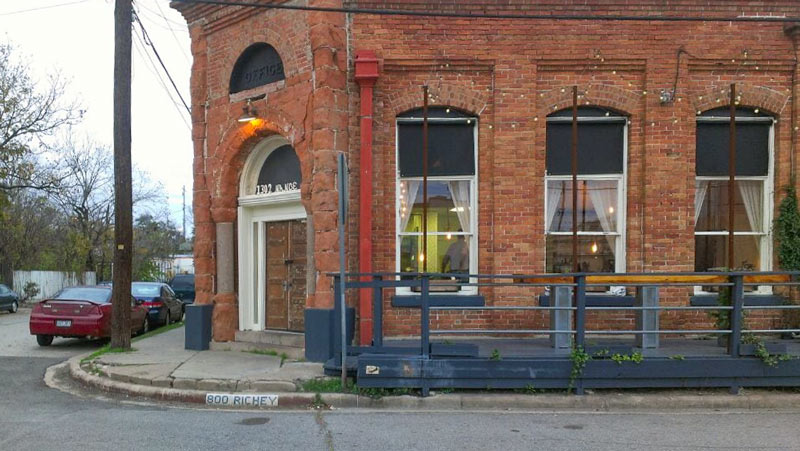 Next in the line of succession for the corner spot at 1302 Nance St. currently occupied by Oxheart: . . . well, something else. So says James-Beard-ed chef and owner Justin Yu, who announced today that the restaurant will close on its 5th birthday in mid-March — to reopen with a new name, a redone interior, and former Oxheart sous chef Jason White at the helm in the kitchen. Eric Sandler notes that Yu will eventually be splitting his hours between the yet-unnamed redo of the Nance space, wine and whiskey bar Public Services in the Cotton Exchange building on Travis, and whatever he’s doing with Bobby Heugel over on Yale St., in the former home of Dry Creek Cafe. [CultureMap; previously on Swamplot] Photo of 1302 Nance St.: Ken L.
Next in the line of succession for the corner spot at 1302 Nance St. currently occupied by Oxheart: . . . well, something else. So says James-Beard-ed chef and owner Justin Yu, who announced today that the restaurant will close on its 5th birthday in mid-March — to reopen with a new name, a redone interior, and former Oxheart sous chef Jason White at the helm in the kitchen. Eric Sandler notes that Yu will eventually be splitting his hours between the yet-unnamed redo of the Nance space, wine and whiskey bar Public Services in the Cotton Exchange building on Travis, and whatever he’s doing with Bobby Heugel over on Yale St., in the former home of Dry Creek Cafe. [CultureMap; previously on Swamplot] Photo of 1302 Nance St.: Ken L.
CITY WANTS TO CREATE HISTORIC DISTRICT TO PROTECT WHAT’S LEFT OF FREEDMEN’S TOWN HISTORIC DISTRICT 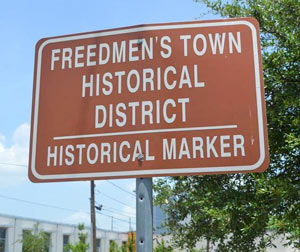 Following last month’s sudden brick relocation incident, Mayor Turner has announced a plan to make a plan to create a “cultural district in Freedmen’s Town — one that would preserve historic churches, schools, and homes,” as Andrew Schneider describes it this week. A section of the Fourth Ward roughly bounded by W. Gray, W. Dallas, Genessee, and Arthur streets has been listed in the National Register of Historic Places since 1985 as the Freedmen’s Town Historic District — but that national designation didn’t provide much local protection to the area’s architecture, and many of the buildings listed in the district’s nomination form to the register have since been demolished. Archi-historian Stephen Fox told Claudia Feldman back in February that a city of Houston historic district designation, however, would be different; Fox noted that “it might require gerrymandering to pick up the proper concentration of historic buildings. But it could be done.” [Houston Public Media and Houston Chronicle; previously on Swamplot] Photo of Freedmen’s Town Historic District sign: Freedmen’s Town Preservation Coalition
Following last month’s sudden brick relocation incident, Mayor Turner has announced a plan to make a plan to create a “cultural district in Freedmen’s Town — one that would preserve historic churches, schools, and homes,” as Andrew Schneider describes it this week. A section of the Fourth Ward roughly bounded by W. Gray, W. Dallas, Genessee, and Arthur streets has been listed in the National Register of Historic Places since 1985 as the Freedmen’s Town Historic District — but that national designation didn’t provide much local protection to the area’s architecture, and many of the buildings listed in the district’s nomination form to the register have since been demolished. Archi-historian Stephen Fox told Claudia Feldman back in February that a city of Houston historic district designation, however, would be different; Fox noted that “it might require gerrymandering to pick up the proper concentration of historic buildings. But it could be done.” [Houston Public Media and Houston Chronicle; previously on Swamplot] Photo of Freedmen’s Town Historic District sign: Freedmen’s Town Preservation Coalition
LICENSE SUSPENSION RECOMMENDED OVER FATAL CALIFORNIAN BALCONY COLLAPSE Meanwhile, in Berkeley: The California Contractors State License Board filed a formal complaint yesterday against the company that worked on the Liberty Gardens Apartments — where a cantilevered balcony in unit 405 collapsed last year, killing 6 of the 13 people standing on it. The board says that Segue Construction (which hired contractors to frame the faulty balcony) deviated from the specified building plan for the balcony, including swapping the plywood called for in the design for multiple sheets of specifically-not-OK oriented strand board. The agency also says the balcony collapsed when it did because of water-intrusion-related dry rot, potentially related to the balcony’s questionable waterproofing — not done in the way the design called for, and completed on “unknown dates” between May 2005 and August 2006 by another contractor. No charges are being filed by the Alameda County district attorney’s office, but the regulatory board is asking that Segue’s license be suspended or revoked. [California Contractors State License Board via KCBS]
CONOCOPHILLIPS TO LEAVE 62-ACRE ENERGY CORRIDOR CAMPUS FOR SOMETHING MORE COZY ACROSS I-10 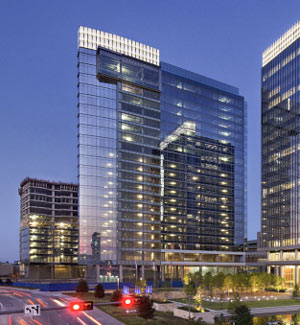 ConocoPhillips told its employees at the 62-acre complex at 600 N. Dairy Ashford Rd. today that the energy giant will be pulling them out of its 1980’s campus and moving them across I-10 into that empty 22-story Energy Center 4 highrise the company has been trying to sublet since earlier this year. Nancy Sarnoff says that the move is planned for mid-2018 after the highrise gets built out, noting that so far, the new building “has remained an empty shell as ConocoPhillips has tried to sublease the space.” Before then, the campus will be getting some new nextdoor neighbors, as Shell’s nearby Woodcreek campus takes on some of the employees being moved out of One Shell Plaza downtown. [Houston Chronicle; previously on Swamplot] Photo of Energy Center 4 at 925 N. Eldridge Pkwy.: CBRE
ConocoPhillips told its employees at the 62-acre complex at 600 N. Dairy Ashford Rd. today that the energy giant will be pulling them out of its 1980’s campus and moving them across I-10 into that empty 22-story Energy Center 4 highrise the company has been trying to sublet since earlier this year. Nancy Sarnoff says that the move is planned for mid-2018 after the highrise gets built out, noting that so far, the new building “has remained an empty shell as ConocoPhillips has tried to sublease the space.” Before then, the campus will be getting some new nextdoor neighbors, as Shell’s nearby Woodcreek campus takes on some of the employees being moved out of One Shell Plaza downtown. [Houston Chronicle; previously on Swamplot] Photo of Energy Center 4 at 925 N. Eldridge Pkwy.: CBRE
APARTMENT DEVELOPER ALLIANCE READY TO BUY LANDMARKED HEIGHTS WATERWORKS LAND 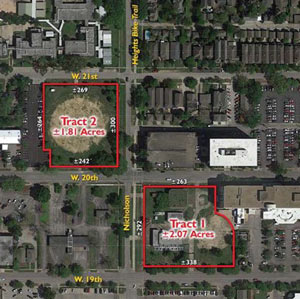 Turns out serial multifamily developer Alliance Residential is the previously unnamed entity planning to buy the Heights waterworks properties the city put on the market earlier this year (after awarding parts of the reservoir complex protected landmark status 6 months prior).  A notice from the city planning department today says Alliance beat out 18 other bidders on the 2 parcels (catty-corner from one another across Nicholson and W. 20th streets), and also mentions that the city has to accept the highest offer for the sale. A public meeting about the plans for the land, including what role those tax-relevant historic structures might have in any proposed new development, is scheduled for the 29th (that’s the Tuesday after Thanksgiving) at the restored fire station on W. 12th St. [Houston Planning Commission] Map of Heights Reservoir properties: City of Houston
Turns out serial multifamily developer Alliance Residential is the previously unnamed entity planning to buy the Heights waterworks properties the city put on the market earlier this year (after awarding parts of the reservoir complex protected landmark status 6 months prior).  A notice from the city planning department today says Alliance beat out 18 other bidders on the 2 parcels (catty-corner from one another across Nicholson and W. 20th streets), and also mentions that the city has to accept the highest offer for the sale. A public meeting about the plans for the land, including what role those tax-relevant historic structures might have in any proposed new development, is scheduled for the 29th (that’s the Tuesday after Thanksgiving) at the restored fire station on W. 12th St. [Houston Planning Commission] Map of Heights Reservoir properties: City of Houston
COMMENT OF THE DAY: WHAT MADE THE GEOGRAPHY THAT MADE HOUSTON  “Air conditioning had little to do with it. Chicago out-paced Houston because of its location as the geographic nexus of industrial transportation during the industrial revolution. It connected to the east through the Erie Canal and Great Lakes and to the west with the ever-growing railroads. A linchpin city grows. A growing city builds. Houston had no such geographic importance — and had a hurricane not made Galveston nonviable, Houston would probably still be a modest town. We had to build our port to earn any geographic value. It’s impressive that we did so. Houston shouldn’t exist. We made it exist. Now that’s cool.” [Matt, commenting on Comment of the Day: When Houston Chilled Out and Grew Up] Photo of Houston Ship Channel: Russell Hancock via Swamplot Flickr Pool
“Air conditioning had little to do with it. Chicago out-paced Houston because of its location as the geographic nexus of industrial transportation during the industrial revolution. It connected to the east through the Erie Canal and Great Lakes and to the west with the ever-growing railroads. A linchpin city grows. A growing city builds. Houston had no such geographic importance — and had a hurricane not made Galveston nonviable, Houston would probably still be a modest town. We had to build our port to earn any geographic value. It’s impressive that we did so. Houston shouldn’t exist. We made it exist. Now that’s cool.” [Matt, commenting on Comment of the Day: When Houston Chilled Out and Grew Up] Photo of Houston Ship Channel: Russell Hancock via Swamplot Flickr Pool
COMMENT OF THE DAY: WHEN HOUSTON CHILLED OUT AND GREW UP  “I have 3 words that explain why Chicago developed as a ‘modern city’ well before Houston: ‘winter’ and ‘air conditioning.’ Think about it . . . Heating a big tall building to make it comfortable is easy. In contrast, cooling that same building is not so easy — especially in the post Civil War and 1890-1920 time frame. Now, the development of commercially viable air conditioners in the 1920-30’s was an expensive luxury. Then the WW2 years and rationing, and voilá — [only] modest growth of ‘big city’ until the late 1940’s and 1950’s. So when did Houston really start to grow? Yup, you guessed it: post WW2 and the 1950’s, when most middle class people could afford air conditioning in their homes and businesses. So if you want cool ‘old’ pre-war buildings, go north and east towards cooler weather. But if you want a modern or post-modern or even contemporary building, just look at Houston, or Atlanta, or Los Angeles, or Las Vegas. (And thank Mr. Carrier for his invention of air conditioning as we know it.)” [In the Doghouse, commenting on A Brief History of Houston’s Future Historic Preservation Culture] Illustration: Lulu
“I have 3 words that explain why Chicago developed as a ‘modern city’ well before Houston: ‘winter’ and ‘air conditioning.’ Think about it . . . Heating a big tall building to make it comfortable is easy. In contrast, cooling that same building is not so easy — especially in the post Civil War and 1890-1920 time frame. Now, the development of commercially viable air conditioners in the 1920-30’s was an expensive luxury. Then the WW2 years and rationing, and voilá — [only] modest growth of ‘big city’ until the late 1940’s and 1950’s. So when did Houston really start to grow? Yup, you guessed it: post WW2 and the 1950’s, when most middle class people could afford air conditioning in their homes and businesses. So if you want cool ‘old’ pre-war buildings, go north and east towards cooler weather. But if you want a modern or post-modern or even contemporary building, just look at Houston, or Atlanta, or Los Angeles, or Las Vegas. (And thank Mr. Carrier for his invention of air conditioning as we know it.)” [In the Doghouse, commenting on A Brief History of Houston’s Future Historic Preservation Culture] Illustration: Lulu
CITY TRACKING DOWN THE LEAD IN CITY HALL’S DRINKING FOUNTAINS, EYEING OTHER DOWNTOWN FAUCETS 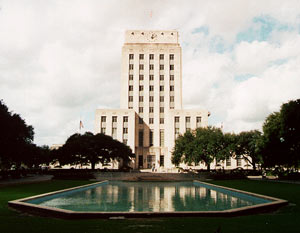 The city is planning to check in on the water at other buildings downtown, Scott Noll reports, in the wake of those lead tests KHOU did on drinking water from just City Hall and the City Hall Annex buildings last week. Those tests turned up lead levels so high above federal limits in at least 1 fountain that the city has shut them all off (and cleaned out the ice machines) while more extensive testing is done on the system. City spokesperson Janice Evans says city testing a few years ago didn’t show concern-worthy lead levels, but the fountains will stay off while the source of the current problem is traced out: “Is it the pipes? Is it the drinking fountains? Is it water coming into the building? It could be [any of the 3] options. There’s a lot of deferred maintenance in this building.”  [KHOU; previously on Swamplot] Photo of City Hall: City of Houston
The city is planning to check in on the water at other buildings downtown, Scott Noll reports, in the wake of those lead tests KHOU did on drinking water from just City Hall and the City Hall Annex buildings last week. Those tests turned up lead levels so high above federal limits in at least 1 fountain that the city has shut them all off (and cleaned out the ice machines) while more extensive testing is done on the system. City spokesperson Janice Evans says city testing a few years ago didn’t show concern-worthy lead levels, but the fountains will stay off while the source of the current problem is traced out: “Is it the pipes? Is it the drinking fountains? Is it water coming into the building? It could be [any of the 3] options. There’s a lot of deferred maintenance in this building.”  [KHOU; previously on Swamplot] Photo of City Hall: City of Houston
PERMITS ISSUED TO STORE TEXAS WIND ENERGY IN GIANT UNDERGROUND SALT CAVE, TOO Meanwhile, in Tennessee Colony: As Fairway works on retrofitting some of those giant salt caves south of the Astrodome to store crude oil, a company called APEX says it has the permits all lined up to outfit a cavern in Anderson County’s Bethel Salt Dome to store some of Texas’s excessive wind energy. The plan, if the company gets the rest of the necessary funding, is to buy excess electricity from the grid to run an air compressor, pumping air into a salt chamber as deep as the Empire State Building is tall. That compressed air (with a boost from some natural gas combustion) would then be used to turn a turbine when needed. Energy analyst Paul Denham tells David Fehling that only a few spots in the US along the Gulf Coast have the kind of salt dome geology being put to work by the Bethel project (and by the only other major compressed air plants in the world, currently operating in Germany and Alabama); a few other companies, however, are now working on taking underground caverns out of the equation. [Houston Public Media; previously on Swamplot]
A BRIEF HISTORY OF HOUSTON’S FUTURE HISTORIC PRESERVATION CULTURE  “Houston seems younger than it is,” writes Barry Moore today: “Few would guess that our founding by the Allen Brothers was within a few years of Chicago’s. Why does Chicago seem so much older? The answer is complex.” While the 70-year-old annual conference of the National Trust for Historic Preservation kicks off today in Houston for the first time, Moore charts decades of change in Houston’s laws, tax rules, and attitudes related to letting historic structures and places stick around. And Moore claims that these days, Houston’s out-with-the-old reputation “is itself a relic. Houston has turned a corner. After half a century of organizing, we now have a preservation culture and laws to protect parts of the built environment. This may be hard to believe, but I will argue that no other city in the country has such an opportunity to become ground zero for the future of the preservation movement.” [OffCite; previously on Swamplot] Photo of Astrodome: Russell Hancock via Swamplot Flickr Pool
“Houston seems younger than it is,” writes Barry Moore today: “Few would guess that our founding by the Allen Brothers was within a few years of Chicago’s. Why does Chicago seem so much older? The answer is complex.” While the 70-year-old annual conference of the National Trust for Historic Preservation kicks off today in Houston for the first time, Moore charts decades of change in Houston’s laws, tax rules, and attitudes related to letting historic structures and places stick around. And Moore claims that these days, Houston’s out-with-the-old reputation “is itself a relic. Houston has turned a corner. After half a century of organizing, we now have a preservation culture and laws to protect parts of the built environment. This may be hard to believe, but I will argue that no other city in the country has such an opportunity to become ground zero for the future of the preservation movement.” [OffCite; previously on Swamplot] Photo of Astrodome: Russell Hancock via Swamplot Flickr Pool
SPURNED BY NORWEGIAN, PRINCESS, BAYPORT CRUISE TERMINAL TURNS TO CHILLIN’ FRUIT, FIXING UP CARS  Bereft of tourist companionship after little more than a pair of brief affairs with Norwegian and Princess cruise lines (both of which ended abruptly in mid-2015), the $108-million Bayport Cruise Terminal is picking up and moving on next month, when the first shipment of automobiles for Auto Warehousing Inc. is scheduled to make landing. Andrea Rumbaugh writes that the company has a 3-year lease to use the former cruise facility to make after-market mods before sending cars on their way to dealerships; port commission chairwoman Janiece Longoria also tells Rumbaugh that port-owned areas near the terminal are being outfitted with more chilled storage space, possibly paving the way for the failed Ship Channel vacation destination to make a comeback as a fruit-and-veggie hub. [Houston Chronicle; previously on Swamplot] Photo: Port of Houston
Bereft of tourist companionship after little more than a pair of brief affairs with Norwegian and Princess cruise lines (both of which ended abruptly in mid-2015), the $108-million Bayport Cruise Terminal is picking up and moving on next month, when the first shipment of automobiles for Auto Warehousing Inc. is scheduled to make landing. Andrea Rumbaugh writes that the company has a 3-year lease to use the former cruise facility to make after-market mods before sending cars on their way to dealerships; port commission chairwoman Janiece Longoria also tells Rumbaugh that port-owned areas near the terminal are being outfitted with more chilled storage space, possibly paving the way for the failed Ship Channel vacation destination to make a comeback as a fruit-and-veggie hub. [Houston Chronicle; previously on Swamplot] Photo: Port of Houston
COMMENT OF THE DAY: THE NUMBERS ON HEIGHTS WETTING AND THE PRESIDENCY 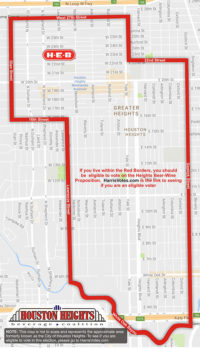 “Prop. 1 passed by 2087 votes. There were 654 undervotes (voters who voted but didn’t vote on Prop 1.), of which only 143 were on election day. By the way: 78 percent turnout in the damp Heights, and 72 percent of registered voters voted on Prop 1. — compared to about 60 percent county-wide and 55 percent nationally for the Presidential election.” [Angostura, commenting on Your Heights Dry Zone Ballot Problem Didn’t Affect Yesterday’s Moist Election Outcome] Map of proposed H-E-B in Heights damp zone: Houston Heights Beverage Coalition
“Prop. 1 passed by 2087 votes. There were 654 undervotes (voters who voted but didn’t vote on Prop 1.), of which only 143 were on election day. By the way: 78 percent turnout in the damp Heights, and 72 percent of registered voters voted on Prop 1. — compared to about 60 percent county-wide and 55 percent nationally for the Presidential election.” [Angostura, commenting on Your Heights Dry Zone Ballot Problem Didn’t Affect Yesterday’s Moist Election Outcome] Map of proposed H-E-B in Heights damp zone: Houston Heights Beverage Coalition
CITY STILL WORKING ON CHANGING DOWLING STREET’S NAME, STREET NAME CHANGING RULES  The renaming of Dowling St. to Emancipation Ave. is taking a little longer than the 10 weeks initially planned by the city planning commission, Mike Morris notes this week (now that that floated November 6 renaming ceremony date has come and gone). The final votes to formalize the name change are still coming up; the mayor and city council have also been rethinking the rules on how to change street names, which currently require a written OK from 75 percent of the property owners along a public street. Fewer than half of Dowling St.’s property owners initially signed on to the change,  though that percentage is skewed by the fact that many absentee owners couldn’t be reached at all, according to state rep Garnet Coleman. Morris writes that the proposed rule updates just require “sufficient” support for a name change to go through; the renaming of Dowling is moving forward under the new rules as a trial run before the city approves the rules officially. [Houston Chronicle; previously on Swamplot] Rendering of in-progress Emancipation Park redo on Dowling St.: Phil Freelon
The renaming of Dowling St. to Emancipation Ave. is taking a little longer than the 10 weeks initially planned by the city planning commission, Mike Morris notes this week (now that that floated November 6 renaming ceremony date has come and gone). The final votes to formalize the name change are still coming up; the mayor and city council have also been rethinking the rules on how to change street names, which currently require a written OK from 75 percent of the property owners along a public street. Fewer than half of Dowling St.’s property owners initially signed on to the change,  though that percentage is skewed by the fact that many absentee owners couldn’t be reached at all, according to state rep Garnet Coleman. Morris writes that the proposed rule updates just require “sufficient” support for a name change to go through; the renaming of Dowling is moving forward under the new rules as a trial run before the city approves the rules officially. [Houston Chronicle; previously on Swamplot] Rendering of in-progress Emancipation Park redo on Dowling St.: Phil Freelon
HISD PROP 1 VOTERS TO STATE: COME AND TAKE IT OR MAYBE DO SOMETHING ELSE INSTEAD  While the Heights Dry Zone was dampened yesterday by a 63-to-36-percent moistening vote for City of Houston Prop. 1, HISD’s non-alcohol-related Prop. 1 was shot down yesterday by about the same margin (62-to-37-percent against). Laura Isensee writes that the measure was on the ballot this year because Houston’s rising property tax values have put it above a wealth threshold requiring it to share revenue into the state’s education funding system, “even if the majority of its students come from low-income households.” Crossing that threshold means the district was asked to send around $162 million this year to be distributed around; the ‘no’ vote however, denied the district permission to send the money the usual way (which no district has ever refused to do before). To get at the funds, the state could redraw the boundaries of HISD to move some higher-tax-value property into other nearby districts — or it could overhaul the education funding system during this year’s legislative session, as that Texas Supreme Court ruling in May strongly recommended (but did not order). Isensee writes that mayor Turner and others who campaigned against the proposition are hoping the vote will spur the Legislature to reform education funding in the upcoming session; lieutenant governor Dan Patrick has already said a special summer session could be called to tackle the issue, while governor Greg Abbott has already said that won’t be necessary. [Houston Public Media] Photo of HISD central office at 4400 West 18th St.: HISD
While the Heights Dry Zone was dampened yesterday by a 63-to-36-percent moistening vote for City of Houston Prop. 1, HISD’s non-alcohol-related Prop. 1 was shot down yesterday by about the same margin (62-to-37-percent against). Laura Isensee writes that the measure was on the ballot this year because Houston’s rising property tax values have put it above a wealth threshold requiring it to share revenue into the state’s education funding system, “even if the majority of its students come from low-income households.” Crossing that threshold means the district was asked to send around $162 million this year to be distributed around; the ‘no’ vote however, denied the district permission to send the money the usual way (which no district has ever refused to do before). To get at the funds, the state could redraw the boundaries of HISD to move some higher-tax-value property into other nearby districts — or it could overhaul the education funding system during this year’s legislative session, as that Texas Supreme Court ruling in May strongly recommended (but did not order). Isensee writes that mayor Turner and others who campaigned against the proposition are hoping the vote will spur the Legislature to reform education funding in the upcoming session; lieutenant governor Dan Patrick has already said a special summer session could be called to tackle the issue, while governor Greg Abbott has already said that won’t be necessary. [Houston Public Media] Photo of HISD central office at 4400 West 18th St.: HISD

